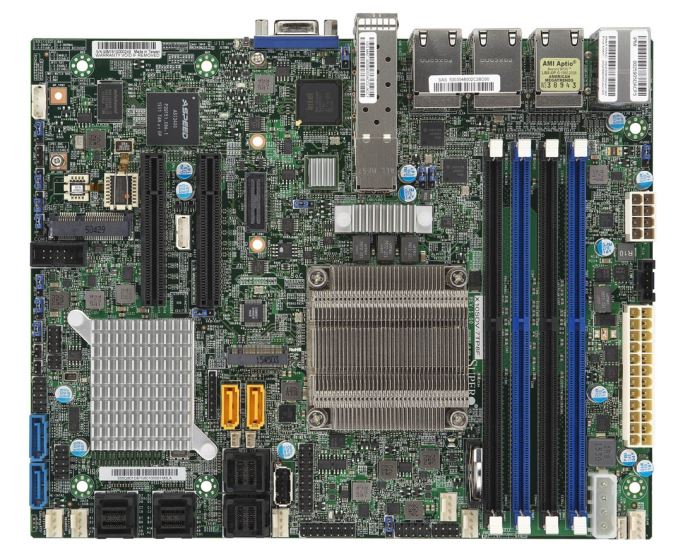Investigating Cavium's ThunderX: The First ARM Server SoC With Ambition
by Johan De Gelas on June 15, 2016 8:00 AM EST- Posted in
- SoCs
- IT Computing
- Enterprise
- Enterprise CPUs
- Microserver
- Cavium
The Top of the Line Xeon D: 16 Cores At 2.3 GHz
The Xeon D-1557 is a Xeon D with 12 cores running at 1.8 GHz most of the time (1.5 GHz base clock) that can boost to 2.1 GHz in single threaded circumstances. The reason for the modest clockspeed is simply the relatively low 45W TDP.
So if you need more CPU compute power, Intel has recently launched the Xeon D-1581, which contains 16 cores (32 threads) which can run at 2.3 GHz most of the time (1.8 GHz base), and boosts to 2.4 GHz. It does not seem to be available to everybody quite yet, but it is simply the slightly more powerful version of the earlier 1587, which runs one speed grade slower (1.7-2.3 GHz). Intel has not disclosed pricing yet, but it is not too hard to figure out. The Xeon D-1587 costs a daunting $1754, so it is very likely that the slightly faster Xeon D-1581 is around $1850.
To make the Xeon D-1581 equipped Supermicro X10SDV-7TP8F attractive, Supermicro turned it into a very luxurious board. They added the LSI 2116 RoC chip which adds up to 16 SATA3/SAS2 ports, and an Intel i350-AM4 (4 extra gigabit ports) and an Intel I210 (2 extra gigabit ports). So in total you can attach 4x SATA disks, 16x SAS disks, 6x GigE and 2x 10 GbE connections. Although we are impressed with the I/O capabilities, we feel that the Ethernet configuration is a bit too much of a good thing. If you configured something wrong, the fact that 3 different NIC chips are present makes debugging it harder. Nevertheless, it is an interesting alternative for a large part of the server market that does not need a 2 socket Xeon E5 but still needs a lot of local I/O.











82 Comments
View All Comments
silverblue - Thursday, June 16, 2016 - link
I think AMD themselves admitted that the Opteron X1100 was for testing the waters, with K12 being the first proper solution, but that was delayed to get Zen out of the door. I imagine that both products will be on sale concurrently at some point, but even with AMD's desktop-first approach for Zen, it will probably still come to the server market before K12 (both are due 2017).junky77 - Thursday, June 16, 2016 - link
still, quite strange, no? AMD is in the server business for years. I'm not talking about their ARM solution only, but their other solutions seem to be less interesting..silverblue - Thursday, June 16, 2016 - link
I am looking forward to both Zen and K12; there's very little chance that AMD will fail with both.name99 - Wednesday, June 15, 2016 - link
" It is the first time the Xeon D gets beaten by an ARM v8 SoC..."The Apple A9X in the 12" iPad Pro delivers 40GB/s on Stream...
(That's the Stream built into Geekbench. Conceivably it's slightly different from what's being measured here, but it delivers around 25GB/s for standard desktop/laptop Intel CPUs, and for the A9 and the 9" iPad's A9X, so it seems in the same sort of ballpark.)
aryonoco - Thursday, June 16, 2016 - link
Fantastic article as always Johan. Thank you so much for your very informative articles. I can only imagine how much time and effort writing this article took. It is very much appreciated.The first good showing by an ARMv8 server. Nearly 5 years later than expected, but they are getting there. This thing was still produced on 28 HKMG. Give it one more year, a jump to 14nm, and a more mature software ecosystem, and I think the Xeons might finally have some competition on their hands.
JohanAnandtech - Thursday, June 16, 2016 - link
Thank you, and indeed it was probably the most time consuming review ... since Calxeda. :-)Yes, there is potential.
iwod - Thursday, June 16, 2016 - link
Even if the ThunderX is half the price of equivalent Xeon, I would still buy Intel Xeon instead. This isn't Smartphone market. In Server, The cost memory and Storage, Networking etc adds up. Not only does it uses a lot more power in Idle, the total TCO AND Pref / Watts still flavours Intel.There is also the switching cost of Software involved.
And those who say Single Core / Thread Performance dont matter have absolutely no idea what they are talking about.
As far as I can tell, Xeon-D offers a very decent value proposition for even the ARM SoC minded vendors. This will likely continue to be the case as we move to 10nm. I just dont see how ARM is going to get their 20% market share by 2020 as they described in their Shareholder meetings.
rahvin - Thursday, June 16, 2016 - link
If you have to switch software on your severs because you switch architecture you are doing something wrong and are far too dependent on proprietary products. I'm being a bit facetious here but the only reason architecture should limit you is you are using Microsoft products or are in a highly specialized computing field. Linux should dominate your general servers.kgardas - Friday, June 17, 2016 - link
Even if you are on Linux, still stack support is best on i386/amd64. Look at IBM how it throws a lot of money to get somewhere with POWER8. ARM can't do that, so it's more on vendors to do that and they are doing it a little bit more slowly. Anyway, even AArch64 will mature in LLVM/GCC tool chain, GNU libC, musl libC, linux kernel etc but it'll take some time...tuxRoller - Thursday, June 16, 2016 - link
Aarch64 has very limited conditional execution support.http://infocenter.arm.com/help/index.jsp?topic=/co...